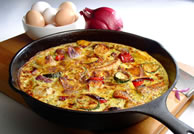Are you starting to see how our bodies naturally have a variety of ways to clear and cleanse themselves? Unfortunately, with all of the toxins we keep feeding ourselves, and those proliferating in our environment, its hard for the body to keep up. Even 20 years ago, there wasn’t the toxic load on the earth that there is today. Manufacturers continue creating foods that just do not serve our body’s health. And we keep buying them – blissfully unaware of the damage they create.
The intestines
After leaving the stomach where food mixes with stomach acid and enzymes, the acid is neutralized and more enzymes and bile are added into the mix. In the small intestine valuable nutrients are removed from the food and what cannot be used to feed the body is driven through into the large intestine with its muscular movements.
In the large intestine, water and remaining minerals are removed from the food and the rest is eliminated through bowel movements. One bowel movement for each meal consumed is the ideal for keeping the large intestine moving without backed up waste.
Unfortunately, it is rare for us to have the ideal in terms of bowel movements. The combined effects of stress, low fibre diet, insufficient hydration and lack of exercise can cause waste to build up on the large intestine’s walls, forming crusts and pockets where bacteria, yeast and other microorganisms proliferate and infection can follow.
We can support the elimination process through the intestines by consuming a diet high in fibre (about 30 grams of fibre per day is a good starting point), 1.5 to 2 litres of water per day, add probiotics to keep our gut ecology (or the “good bacteria”) healthy, regular exercise to stimulate the movement of muscles and avoid antibiotics which disrupt the balance of our body.
The kidneys
The kidneys take care of the elimination of water-soluble toxins and excess minerals. They are filled with about one million tiny filtration units called nephrons, which collectively cleanse 180 litres of blood each day.
Water, and lots of it, is the best way to support our kidneys in their elimination role. Drink water (1 ½ to 2 litres) free of chemicals and pesticides. There are many water purification systems available to fit any budget. My family uses a counter-top Santevia filtration system that was in the $160 range and we change the filters per the instructions – which cost about the start-up price annually.
Another way to support the kidneys is to maintain a low sodium/high potassium diet to increase the efficiency of cellular detoxification and elimination via the kidneys. Sodium is present in the fluid outside each cell, potassium inside each cell. When one is low, the other will be high. If sodium levels are high, the body’s cells may swell and trap toxins inside. Restricting sodium consumption allows less fluid retention. Potassium preserves alkalinity of the body fluids and encourages the kidneys to eliminate toxic waste products.
Foods with the best low sodium/high potassium ratios are navy beans, caraway seeds (also good for increasing Phase 1 liver detox), dark cherries, dried apricots, lentils, walnuts, oranges, almonds, apples, avocado, peaches, banana, grapefruit, pineapple, squash, sage, mint and apple cider vinegar.
The thymus gland
The thymus gland, which lies just beneath the breast bone, is the main immune organ of the body. It is large in infants, and shrinks as we age. Its function is to program white blood cells, the body’s immune army, in their various tasks and then sends them into the blood to recognize and destroy pathogens.
The thymus develops our resistance to bacteria, cancer, viruses, toxins and allergens and stimulates the production of white blood cells in the bone marrow. It controls the lymphatic system of glands and ducts by turning up the volume on the elimination of wastes.
This gland is highly responsive to our emotions and shuts down when we are feeling stressed, unfulfilled, and without purpose. As a result, the white blood cells become fewer in number and less aggressive.
Support for the thymus gland can be achieved through a healthy diet, healthy sleep patterns so that the body produces melatonin and receives adequate rest, water and exercise, and responds best to our learning to manage stress effectively.
Antioxidants like vitamins C and E, beta carotene and selenium are critical to protect the thymus from free radical damage. Other nutrients such as zinc and vitamin B6 are important because they are required for the production of thymic hormones.
Eggs can be eaten during a detoxification program because the protein is more easily absorbed than any other protein, except for whey. To enrich more anti-oxidant power, add fresh herbs from your garden, such as basil or parsley.
Zucchini, Pepper and Goat Cheese Frittata
2 tsp. olive oil
2 cups mixed diced vegetables (choose from zucchini, asparagus, spinach, broccoli, and/or onions
1/2 red pepper, diced
1/2 tsp. salt with trace minerals
1/2 tsp cayenne pepper
8 large eggs
6 green onions, chopped
½ cup minced parsley or mixture of fresh green herbs
2 garlic cloves, minced
1 cup crumbled goat cheese
Dulse to sprinkle on the top
Preheat the oven to 350 F. Chop the green vegetables, onions, and red pepper and green onions. Heat a cast iron skillet over medium heat. Heat olive oil and sauté vegetables, stirring occasionally for five minutes.
In a large bowl, whisk the eggs, cayenne pepper and salt and pour over the vegetables. Add green onions, herbs, and basil. Crumble the goat cheese on top.
Let it cook undisturbed over moderate heat for three to four minutes, until eggs are set on the bottom and edges. Transfer to the oven and cook for 15 to 20 minutes until eggs are cooked in the centre and the goat cheese is slightly brown.
Serve it in the hot skillet, or later at room temperature. Cut into wedges. Sprinkle with dulse. Serve with a spinach salad.

